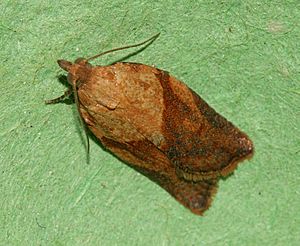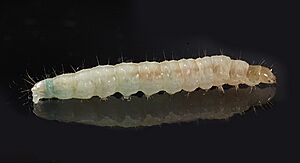Light brown apple moth facts for kids
Quick facts for kids Light brown apple moth |
|
|---|---|
 |
|
 |
|
| Scientific classification | |
| Genus: |
Epiphyas
|
| Species: |
postvittana
|
The light brown apple moth (Epiphyas postvittana), often called LBAM, is a type of moth. It belongs to a group of moths known as leafrollers. These moths are part of the Tortricidae family.
Contents
Identifying the Light Brown Apple Moth
Adult Moths: What They Look Like
Adult light brown apple moths can look different from each other. They can also be hard to tell apart from other similar moths. To be absolutely sure, scientists often use DNA tests.
Male moths usually have wings that are about 6–10 mm long. Their wings are light brown near the body and darker, reddish-brown at the tips. Sometimes, the darker tip area is missing, and the moth looks all light brown.
Female moths are usually a bit larger, with wings 7–13 mm long. Their wings are mostly light brown, with slightly darker lines at the tips.
Larvae: The Caterpillar Stage
The young moths, called larvae or caterpillars, are also hard to identify. They look very similar to other leafroller caterpillars. Again, DNA testing is the best way to know for sure.
When they first hatch, the larvae have dark brown heads. As they grow, their heads turn a light tan color. Larvae that spend the winter are often darker.
Tiny new larvae are about 1.6 mm long. Fully grown larvae can be 10–18 mm long. Their bodies are usually medium green. They have a darker green stripe down their back and two stripes along their sides.
Where Light Brown Apple Moths Live
The light brown apple moth originally comes from Australia. Over time, it has spread to many other places. These include New Caledonia, the British Isles, Hawaii (since 1896), and New Zealand.
In March 2007, the moth was found in California, USA. DNA tests confirmed its presence across many areas, from Los Angeles to Napa, north of San Francisco.
Life Cycle of the Light Brown Apple Moth
Light brown apple moths usually have three generations each year. Sometimes, there's even a partial fourth generation. These moths do not have a special resting stage in winter. This means different generations can be active at the same time.
In warmer places, they can complete four or five generations a year. Major flying periods happen in September–October, December–January, February–March, and April–May. In cooler areas, they might only have two full generations.
Female moths lay their eggs in groups of 3 to 150. They place these egg clusters on leaves or fruit. One female can lay hundreds of eggs in her lifetime.
Adult moths from the winter generation appear in October and November. These adults lay eggs for the first summer generation. The larvae from this group grow up between January and mid-February.
Larvae from the second generation mature in March and April. The adults from this group then lay eggs for the third generation. During winter, the larvae grow much slower, especially when it's cold. Most larvae spend the winter as young caterpillars. They usually eat herbaceous plants (plants with soft stems) during this time.
In October to December, the moths start laying eggs on apple trees again. This is when the third generation moths begin their egg-laying.
How Moths Attract Each Other: Sex Pheromones
Female light brown apple moths release special chemicals called pheromones. These pheromones are like a scent that attracts male moths. The scent is a mix of two main compounds.
Scientists can make these pheromones in a lab. They use them in moth traps to monitor moth populations. These synthetic pheromones are very specific. Only light brown apple moths and very similar species are attracted to their scent.
What Light Brown Apple Moths Eat and the Damage They Cause
The light brown apple moth is a herbivore, meaning it eats plants. It's also a generalist, which means it can eat many different kinds of plants. Its larvae feed on a wide range of crops in Australia and New Zealand. In these places, they don't have many natural enemies.
This moth is known to eat over 120 different plant species. These include many native Australian plants. In New Zealand, over 250 host plants have been recorded. They eat almost all types of fruit crops, garden plants, vegetables, and even young pine trees.
The larvae cause a lot of damage to leaves and fruit. Young larvae feed on the underside of leaves, hidden under silky webs they build. As they get bigger, they move to new spots. They might feed between two leaves, or between a leaf and a fruit. They can also feed inside developing buds or on a single rolled-up leaf. Older larvae eat most of the leaf, leaving only the main veins. They can also tunnel into berries like strawberries.
Damage to fruit is common, especially in apples that grow in tight clusters. The larvae often spin webs that attach leaves to the fruit. They then feed on the fruit while protected by the leaf. This can make the fruit not good enough to sell. Sometimes, young larvae can even enter the inside of apples, pears, or citrus fruits. They usually push their waste out onto the fruit's surface.
Interestingly, in Hawaii, the moth is not seen as a big problem. The Hawaii Department of Agriculture even says it can be helpful. This is because it helps control some invasive plants, like gorse and blackberry.
In 2008, officials in California stated that there were "no documented crop losses" from the moth at that time.
Controlling Light Brown Apple Moths
The light brown apple moth is considered a harmful insect in the United States and Canada. This means there are rules about moving produce from areas where the moth lives.
Farmers often use a plan called Integrated Pest Management (IPM) to control these moths. IPM uses different methods together. These can include:
- Using special sprays (insecticides).
- Spraying plants with oils to smother insects and their eggs.
- Using biological control, which means using natural enemies like Bacillus thuringiensis (a type of bacteria).
- Sometimes, they use mating disruption. This involves releasing synthetic pheromones. These chemicals confuse the male moths, making it hard for them to find females. This leads to fewer baby moths.
Pheromone lures are also used in traps. These traps help scientists monitor how many moths are in an area. In California, many native parasitoids and predators have been found that attack the moth's eggs and larvae.
Control Efforts in Australia and New Zealand
Since the moth is native to Australia, its natural enemies there usually keep its population under control. However, in New Zealand, it is a pest. For over ten years, New Zealand has used various methods to control it. These include using natural enemies, insecticides, and pheromones to stop mating.
Natural enemies of the moth include certain types of flies and wasps. These are parasitoids. This means they lay their eggs on or inside the moth larvae. When the parasitoid egg hatches, the young parasitoid eats the moth larva from the inside, killing it.
The most common parasitoid found with the moth in New Zealand is a wasp called Dolichogenidea tasmanica. This wasp is also native to Australia and likely arrived in New Zealand with the moth. Other common parasitoids include the fly Trigonospila brevifacies and the wasps Glyptapanteles demeter and Goniozus jacintae. These parasitoids together have helped reduce the damage caused by the moth.
Control Efforts in California
It's not known exactly how long the light brown apple moth has been in California. However, in 2007, DNA tests confirmed its presence across many coastal areas. After this, officials started a program to control the moth.
One part of the program involved spraying synthetic pheromones from planes over cities. This caused a lot of public concern. Other methods used included treating plants in nurseries and farms. These treatments used IPM techniques, including pesticides, smothering oils, and biological controls like Bacillus thuringiensis.
The USDA was allowed to use these methods without some of the usual state rules. This was because of an emergency exemption.
After the first round of aerial spraying, many people reported health concerns. Because of this, in June 2008, the California Department of Food and Agriculture changed its plans. They decided to stop spraying over cities. Instead, they started using pheromone-infused twist-ties. These ties release pheromones locally and have worked well in New Zealand.
In December 2015, a court ruled against the moth control program. The court said the program did not follow state environmental laws.






